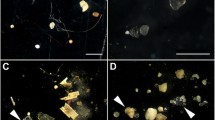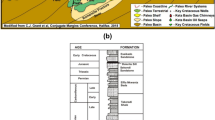Abstract
On 28 January 1989 the Bahia Paraiso ran aground and sank near Palmer Station, Antarctica. At least 6.8 × 105 liters of diesel fuel arctic (DFA) were released into semi-enclosed Arthur Harbor and deposited in the nearby intertidal regions. Approximately 6 weeks later, a group of scientists was deployed to evaluate the impact of the oil spill on the surrounding coastal marine ecosystem.
Microbial hydrocarbon oxidation potential (14CO2 evolved from 14C-labeled hexadecane) was detected throughout both the oil-impacted and control regions. Hexadecane was mineralized at extremely low rates (0.13–1.21 pmol g−1 sediment dry weight day−1); microbiological turnover time exceeded 2 years. The acute effects of DFA (measured over exposure periods of 3–7 days) on the metabolic activities of sedimentary microorganisms appear to be negligible even at seawater saturation concentrations of DFA. Long-term exposure (120 days) to varying concentrations of DFA resulted in significant decreases (>90%) in total ATP, but had either no effect or a slight stimulatory effect on metabolic activity and production. In contrast to planktonic microbial communities, increasing incubation temperatures of between 0 and 30°C had a positive effect on rates of metabolism and production of sedimentary assemblages. These results may influence the overall weathering rates of hydrocarbons deposited in the intertidal and supratidal regions of Arthur Harbor and other polar regions.
Similar content being viewed by others
References
Atlas RM (1981) Microbial degradation of petroleum hydrocarbons: An environmental perspective. Microbiol Rev 45:180–209
Atlas RM, Bartha R (1972) Biodegradation of petroleum in seawater at low temperatures. Can J Microbiol 18:1851–1855
Atlas RM, Bartha R (1972) Degradation and mineralization of petroleum in sea water: Limitation by nitrogen and phosphorus. Biotech Bioeng 14:309–318
Atlas RM, Boehm PD, Calder JA (1981) Chemical and biological weathering of oil, from the Amoco Cadiz spillage, within the littoral zone. Est Coast Shelf Sci 12:589–608
Bartha R, Atlas RM (1977) The microbiology of aquatic oil spills. Adv Appl Microbiol 22: 225–266
Caparello DM, LaRock PA (1975) A radioisotope assay for the quantification of hydrocarbon biodegradation potential in environmental samples. Microb Ecol 2:28–42
Colwell RR, Mills AL, Walker JD, Garcia-Tello P, Campos-P V (1978) Microbial ecology studies of the Metula spill in the Straits of Magellan. J Fish Res Board Can 35:573–580
Craven DB, Karl DM (1984) Microbial RNA and DNA synthesis in marine sediments. Mar Biol 83:129–139
Davis JR, Nichols RL (1968) The quantity of melt water in the Marble Point-Gneiss Point area, McMurdo Sound, Antarctica. J Glac 7:313–320
Gibbs CF, Pugh KB, Andrews AR (1975) Quantitative studies on marine biodegradation of oil. II. Effect of temperature. Proc R Soc Lond B 188:83–94
Hodson RE, Holm-Hansen O, Azam F (1976) Improved methodology for ATP determination in marine environments. Mar Biol 34:143–149
Hodson RE, Azam F, Carlucci AF, Fuhrman JA, Karl DM, Holm-Hansen O (1981) Microbial uptake of dissolved organic matter in McMurdo Sound, Antarctica. Mar Biol 61:89–94
Karl DM (1980) Cellular nucleotide measurements and applications in microbial ecology. Microbiol Rev 44:739–796
Karl DM (1982) Selected nucleic acid precursors in studies of aquatic microbial ecology. Appl Environ Microbiol 44:891–902
Karl DM, Holm-Hansen O (1978) Methodology and measurement of adenylate energy charge ratios in environmental samples. Mar Biol 48:185–197
Kelly WC, Zumberge JH (1961) Weathering of a quartz diorite at Marble Point, McMurdo Sound, Antarctica. J Geol 69:433–446
Kennicutt MC II, Sweet ST, Fraser W, Culver ME, Stockton WL, Dunton K, Martin L, Karl DM, Quetin L, Laur D, Amsler CD, Ross RM, Rowley R, Neushul M, Hyland J, Kennett J, Campbell J, Fry M, Todd B, Bennett A, Eppley ZA, Rubega M, Targett T, Grecay P, Palma O, Ferreyra G, Alder V (1990) Oil spillage in Antarctica. Environ Sci Tech 24:620–624
Kennicutt MC II, Sweet ST, Fraser WR, Stockton WL, Culver M (1991) The grounding of the Bahia Paraiso, Arthur Harbor, Antarctica. I. Distribution and fate of oil spill related hydrocarbons. Environ Sci Tech 25:509–518
Leahy JG, Colwell RR (1990) Microbial degradation of hydrocarbons in the environment. Microbiol Rev 54:305–315
Lindstrom JE, Prince RC, Clark JC, Grossman MJ, Yeager TR, Braddock JF, Brown EJ (1991) Microbial populations and hydrocarbon biodegradation potentials in fertilized shoreline sediments affected by the T/V Exxon Valdez oil spill. Appl Environ Microbiol 57:2514–2522
Neori A, Holm-Hansen O (1982) Effect of temperature on rate of photosynthesis in Antarctic phytoplankton. Pol Biol 1:33–38
Author information
Authors and Affiliations
Rights and permissions
About this article
Cite this article
Karl, D.M. The grounding of the Bahia Paraiso: Microbial ecology of the 1989 Antarctic oil spill. Microb Ecol 24, 77–89 (1992). https://doi.org/10.1007/BF00171972
Received:
Revised:
Issue Date:
DOI: https://doi.org/10.1007/BF00171972




